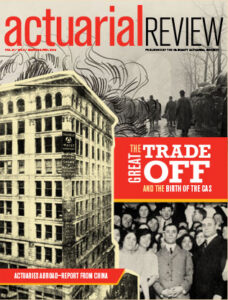
This May-June issue of Actuarial Review marks its 10th year as a four-color magazine. CAS Editorial Production Manager Sarah Sapp, interviews Publications Director Elizabeth Smith as she reflects on the many changes occurring with AR during its new life as a magazine.
Sarah Sapp: Tell me about the beginnings of the magazine. How did it get started and why?
Elizabeth Smith: For years I said that The Actuarial Review[1] was a magazine masquerading as a newsletter. The newsletter’s issues kept getting bigger and bigger – from 16 pages to a whopping 48 pages.
Then one day in early 2013, the head of CAS marketing and communications, Mike Boa, approached me about AR getting a makeover: one complete with paid advertising, full color, and a change from a quarterly to a bimonthly frequency.
These AR changes were part of larger expansion efforts within the CAS to better serve the needs of the growing membership. In just one year, the CAS would be celebrating its centennial and, while there was much to celebrate about the organization’s history, the association sought to make changes to modernize and consistently brand its publications. These changes would benefit an increasing membership and pave the way for an even brighter future for the actuarial profession.
But now my stray comment about the newsletter becoming the size of a magazine was becoming a reality. We only had a few short months to find a designer, determine a new layout and figure out how to keep the magazine filled with stories.
So, I set to work, but I wasn’t alone.
Internally, we formed a dedicated team that included CAS staff members representing the admissions, finance, research, and marketing & communications departments, as well as the publications department’s core team of Staff Editor Donna Royston, Graphic Designer Sonja Uyenco and me. We met over several weeks to accomplish a multitude of tasks, including content planning and RFPs to designers and printers. We also sought the wise counsel of a select group of CAS volunteers, including AR Editor in Chief Grover Edie. Ultimately, we chose great vendors to bring the magazine to life (some of whom are still serving us today – thank you, Mount Royal Printing of Baltimore, Maryland!).
Meanwhile, another group of CAS members and staff had been hard at work to determine a new logo and tagline for the CAS. The first logo was nearly 100 years old, and it was time for a change. Our new CAS logo debuted at the 2013 CAS Spring Meeting in Vancouver and graced AR’s first magazine cover in July of that year.
The most important aspect of the new magazine was the content. With the newsletter, several members contributed several stories over the years. But switching to a bimonthly would not only put new pressure on acquiring content but also on our regular columnists. (Instead of four “Presidents Message” columns per year, the CAS president would now have to write six in the same timeframe.)
The challenge of finding content, supporting regular columnists and illustrating the magazine would be helped by a new budget item for freelance writing and design. (See the sidebar for some of my favorite stories and writers.)
For the new AR section and column names, we took our inspiration from the new CAS tagline of “Expertise. Insight. Solutions.” “Expertise” yielded the department “Actuarial Expertise,” which would house the columns “Brainstorms” (later known as “Explorations”) and other technical discussions of actuarial methods. “Insight” led to “Professional Insight,” where “Ethical Issues” and other stories on career and skills development would find a home. “Solutions” produced “Solve This,” which included perhaps our most popular column, “It’s a Puzzlement.”
SS: How has the magazine changed over the years?
ES: AR progressed from humble print beginnings. Matthew Rodermund started it as The CAS Newsletter. He worked with his wife Edyth in their basement mimeographing, stapling and mailing the newsletter to CAS members beginning in 1970.
Rodermund, who was the editor in chief (EIC) for many years, was a devoted CAS leader. Today the CAS’s most coveted award bears his name: The Matthew Rodermund Memorial Service Award. He later turned over the job to notable CAS members such as Ted Zubulake, Stan Khury, Walter Wright, Paul Lacko and now Grover Edie, who has served as EIC since November 2010.
Mimeographed and stapled sheets morphed into a newsletter that was desktop-designed with the latest software and later introduced duotone photography. Duotones use two inks, one of which is black and the other a signature color chosen by an organization. From the beginning, the CAS’s preferred color was blue, which was chosen for the first edition of the Proceedings of the Casualty Actuarial Society in 1914.
Now we have our four-color magazine (cyan, magenta, yellow and black are used to create a variety of colors). Having color available enabled the magazine to illustrate stories in far greater ways and spurned debate among AR Working Group (ARWG) members on which concepts best depict the cover stories. Now we choose between multiple mock-up designs for some issues, and choosing a cover illustration from several concepts has been a fun and challenging exercise for the AR team.
SS: Tell me about your favorite stories.
ES: I like the stories about people in “Downtime,” “Making Things Happen” and “In Remembrance” columns. In “Downtime” we’ve covered a beekeeper, singer-songwriter, dancers and a forest owner, among many other members with fascinating hobbies. “In Remembrance” has the most poignant stories of our members’ lives — many quite surprising and uplifting. We may be saddened by these people’s passing, but the column celebrates their lives.
One of the most heartwarming stories to grace the pages of AR is “Overcoming the Odds: Actuary Receives Life-Extending Kidney from CAS Classmate” (March/April 2019). It’s about the friendship between CAS Fellows Larry Artes and Kay Kufera, who began their actuarial careers together at the same company. Years after they had left that company and forged their own career paths, the two reconnected when Artes, who had long lived with polycystic kidney disease, began a desperate search for a kidney donor. It turned out that Kufera was a perfect match, and the two colleagues connected in one of the most caring ways. This gift changed the lives of both the donor and recipient. To me, the story of this friendship is emblematic of the ties that CAS members develop through their shared experience of studying and working together. I talked to Grover Edie recently who fondly recalled this story. He told me this story was one of his favorites and an excellent example of what AR is about.
SS: What has been your goal for the magazine?
ES: People like to read about their colleagues, see what’s going on in the organization and learn how they can get involved. I want AR to help members with their jobs — give them tools and resources to advance their careers. Those are the goals — and if AR can entertain as well, that is gravy.
SS: What story or series of stories have we published that you consider groundbreaking?
ES: In late January 2020, we were just learning about COVID-19 and the destruction it was wreaking in Asia and Italy. I spoke to AR’s frequent freelance writer, Annmarie Geddes Baribeau, and asked her to check out the story, with the aim of monitoring the CDC (Centers for Disease Control and Prevention) website and other sites that were keeping track of the diseases deadly toll throughout the world and exploring what it might mean for the P&C industry. Annmarie began her research and by early March 2020 we had our story, just days before COVID was classified as a pandemic.
I’ll never forget a few weeks later on a Friday evening just before quitting work for the day. Annmarie had turned in her story and was telling me more about her research on another COVID story. She was exhausted and so was I. Monitoring COVID’s statistics was frightening. Emotions were raw and the world seemed to be turning upside down, but we had to keep going.
I’m most proud of the work that Annmarie did during that time.
SS: Are there any standout volunteers who really had influence over the years?
ES: When I was hired at the CAS in 1997, we had two copy editors on board as volunteers: Parker Boone and Paul Lacko. Paul and Parker were top-notch editors, and they were my sole support, aside from the EIC. It was a shoestring operation, but we worked well together. Today there are 37 ARWG members. Each one of them brings their unique perspectives to editing articles. Practically every one of them has found something to fix that everyone else has missed!
SS: How do the volunteers help with the AR process?
ES: Our volunteers fact check and review articles with an actuarial eye. They are looking to see that all the concepts are sound and clearly explained, but they are also word lovers. They offer suggestions on just the right words to use — they have improved authors’ writing so much. Often, they have enhanced the clarity and the style of the text. ARWG members enjoy language and are keen on honing that soft skill of communication that the CAS has been encouraging its members to improve upon over the years. They are first-rate communicators who know how to clarify concepts. They question outcomes and look for solutions to sometimes tangled words.
This past April, the ARWG had their first virtual meetings. In all the years I had been working on AR, I had yet to have a meeting with the entire team. We had gotten to know each other through e-mail, but nothing can really compare to that face-to-face interaction. Our first group meetings were a smashing success — we ended up scheduling two meetings on different days so we could get as many people involved as possible. It was so nice to connect people’s names with their faces. We will meet at least twice a year now. I am amazed at and grateful for the dedication of these people who have never met in person.
SS: Where do you see AR going in the future?
ES: Just this year, we introduced digital advertising on our website, so the trend is going toward full-on digital. But honestly, I don’t think print is dead yet. People still like to hold a document in their hands, feel the paper, take it on a plane and then recycle it. While I do love the “deadwood” version, I do foresee a time when AR becomes solely a website or an app. I believe that I will have long been retired when that happens.
One thing that won’t change is the involvement of CAS members. They have established so much of what AR and the CAS are today. I see them continuing to volunteer their time to produce an award-winning publication. And truly, member involvement is the secret to the magazine’s success.
[1] The article “The” would soon disappear from the title of the magazine although many still use it today.

How do you solve a problem like content creation?
Going from a quarterly to a bimonthly publication was tricky. We had plenty of articles before. Would the trend continue? Luckily, we now had a bigger budget for the magazine, which meant that we were able to hire freelance writers for in-depth reporting and design firms for our changing covers – a new one for each issue. We hired staff writers from the Insurance Information Institute as well. We even had some funds for cover designs, which was quite helpful to CAS Graphic Designer Sonja Uyenco who was responsible for nearly all CAS publications.
Over the decade, the work of several dedicated writers and content creators has deepened and enhanced AR. Following are some of these writers and a few of their best works.
Annmarie Geddes Baribeau
- “Driverless Utopia.” May-June 2018. Bronze EXCEL Award for Magazine Feature Article.
- “Gamechanger: After COVID-19, P&C Insurance Will Not Be Quite the Same.” May-June 2020.
- “Demystifying the Regulatory Web: Dodd-Frank and Its Complex Impact.” March/April 2016.
Jessica Leong
 AR’s President’s Message Series 2021 (video interviews with prestigious actuaries). Winner of the Communicator Award of Distinction.
AR’s President’s Message Series 2021 (video interviews with prestigious actuaries). Winner of the Communicator Award of Distinction.
Jim Lynch
- “The Casualty Actuary’s Tools Can Fix All Sorts of Problems.” May-June 2014.
- “Taming the Social Inflation Tiger.” July-August 2021.
- “How To Tap into the AI Revolution.” May-June 2021.
Jim Lynch and Dave Moore
- “Looking for Social Inflation in Loss Development.” September-October 2022.
Liz Haigney Lynch
Laurie McClellan
- “Pioneering CAS Fellows: Linda Shepherd and Ollie Sherman Reflect on their Careers.” January-February 2021.
Steven Sullivan
 “The Great Trade-Off and the Birth of the CAS.” March-April 2014. Winner of a Silver EXCEL Award in the category of Feature Article in a Magazine.
“The Great Trade-Off and the Birth of the CAS.” March-April 2014. Winner of a Silver EXCEL Award in the category of Feature Article in a Magazine.
Special thanks
From Publications, Sonja Uyenco and Sarah Sapp make up the core AR team and Donna Royston lends her expertise when she has time from Variance and Monographs. Sarah Sapp has only been with the CAS for a year, but she has jumped right in and not stopped. She brings her experience writing articles, conducting interviews, editing videos and in general being the voice of reason and curiosity. Sonja Uyenco pulls it all together with wise counsel on what looks good and where copyfitting is needed. CAS staff members often provide content and are great sources for story ideas through their interactions with members. All of these people, the ARWG, the writers and the rest of the CAS members are what make Actuarial Review a vital publication. Thank you all! —Elizabeth A. Smith, AR Managing Editor













